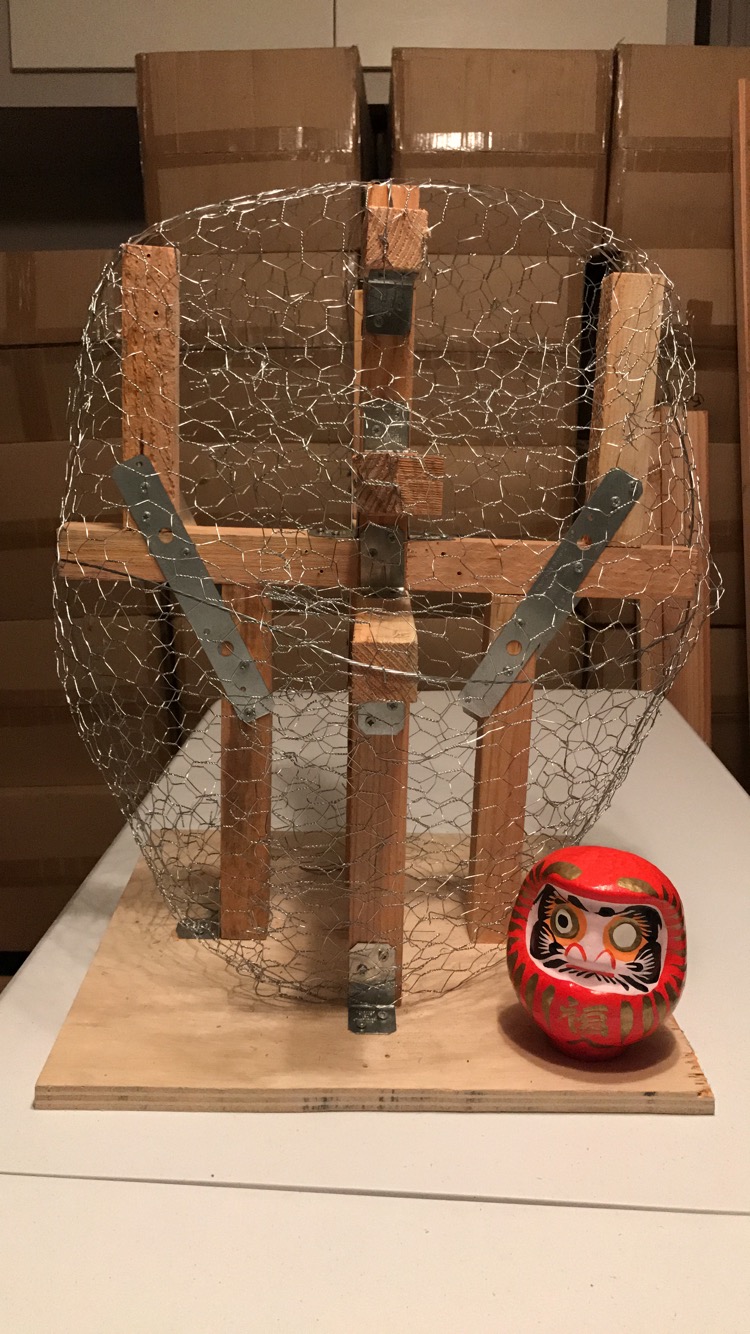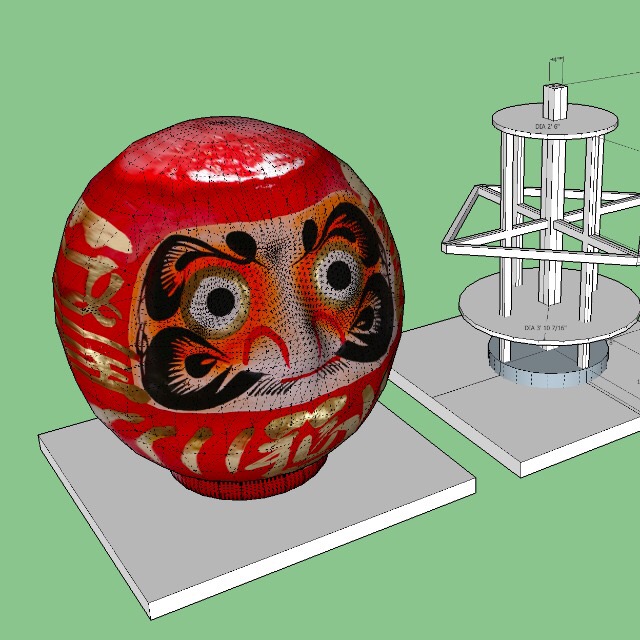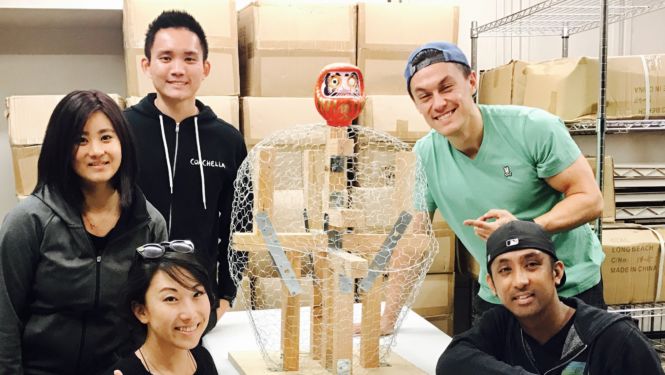Burning Man 2017 honorarium recipient Angela Chang made her first rendition of a Daruma doll for her eighth grade Japanese Culture class. She had never seen a Daruma before, and her creation was a hodgepodge of paper towel rolls and balloons. “I didn’t do well on that project.” Angela laughs.
 Since then, the Daruma has been a recurring image in her life, showing up frequently and refusing to be forgotten. The Daruma doll emerged in Japan in the early 1700s as a symbol of good luck.
Since then, the Daruma has been a recurring image in her life, showing up frequently and refusing to be forgotten. The Daruma doll emerged in Japan in the early 1700s as a symbol of good luck.
It’s a hollow doll, traditionally red, used for obtaining goals. The Daruma is eyeless. The recipient fills in the first eye when setting their goal. Once the goal is obtained, the second eye is filled in and the doll is brought to the temple and burned.
Over her six years going to Burning Man, Angela has brought many Daruma dolls to the playa to gift to people. Her camp, formerly known as the Royal Gypsy Tribe, always wanted to participate more in Black Rock City. They had talked about it for years but could never figure out the right way to activate their crew. When the Radical Ritual theme was announced for Burning Man 2017, the Daruma doll immediately came to mind.
Angela Chang and the Daruma Project team were perimeter volunteers for Mazu Temple in 2015. They’ve been camping together for years, but this is their first large-scale project. The six foot tall wood, wire and papier-mâché Daruma Doll creation is actually their first work of art. “We had never really considered ourselves artists before,” said Angela. On their recent visit to the Burning Man Global Leadership Conference, they suddenly realized they had obtained artist status without even realizing it.
 The crew has reached out to many members of the community for guidance, and they’ve even brought Angela’s father into the fold. He is lending the Daruma project his garage and tools for fabrication, and he’ll be attending his first Burn this year. Angela is excited to have her dad participating in the intention setting ceremonies they will host at the Daruma Doll.
The crew has reached out to many members of the community for guidance, and they’ve even brought Angela’s father into the fold. He is lending the Daruma project his garage and tools for fabrication, and he’ll be attending his first Burn this year. Angela is excited to have her dad participating in the intention setting ceremonies they will host at the Daruma Doll.
These ceremonies will gather groups of two or three people to set goals, dot the eye of the Daruma together, and hold each other accountable for following through on their intention. They will also host discussions about intention setting at their camp. “I hope it inspires people to realize that their intentions are achievable,” says Angela.
Interestingly, no one in this group of Asian-American Burners is of Japanese descent, but they feel a deep connection to and love for the culture. In addition to the ritual goals, they hope the Daruma will inspire deeper conversations about Radical Inclusion and diversity. They see their creation as a positive moment to talk about culture.
Right now the team is in the midst of purchasing building materials, and soon they will do another wood test to make sure their process will last on the playa. They’re so excited to gift this ancient, physical representation of goal achieving at Burning Man this year. Be sure to look out for the giant red Daruma Doll on playa and use its magic to help achieve your intention for the future.


Great story! Looking forward to seeing the Daruma Doll on the playa~~
Report comment
<3
Report comment
The Daruma Project strongly resonates with The Intention Station, the art project of my camp (Shack of Sit)! Let’s meet up and multiply the effect. SYOTP
Report comment
Would love to connect! :)
Report comment
If they aren’t of Japanese decent isn’t this cultural appropriation under the guise of diversity?
Report comment
Hi! Totally valid concern, so I wanted to address it head on.
A lot of us on the build team have deep connections & a long history with Japanese culture, despite the fact we’re not ethnically Japanese. My grandparents grew up under Japanese occupation in Taiwan, and as a result, Japanese culture is a part of my family history. The same is true for several other members of our team. Hope that helps to explain things!
Report comment
Not really, since you are misappropriating a Buddhist idol for the sake of diversity. The Japanese also misappropriated it by reducing it to a good luck charm. It’s also pretty noninclusive towards other religions with it’s Zen Buddhist origins. Also, are you planning on making an Onna Daruma since the doll is typically masculine, perpetuating patriatchal oppression?
Report comment
Replying to Throwaway…
I get what you’re saying and I think cultural appropriation is a huge issue at Burning Man as well. I’m thankful you brought it up. In this case, though, I think it’s a bit more complicated than labeling this as cultural appropriation. Angela said that her family grew up in Taiwan under Japanese occupation. It’s difficult for an occupied population not to be influenced by and adopt (whether forcibly or voluntarily) the customs and practices of the occupying group – in this case, the Japanese. This is more a practice of acculturation and assimilation than misappropriation. And I think it is very different than a white person deciding to practice Buddhism or donning a Native American headdress at Burning Man because they like it or because it “speaks” to them.
I think our battles would be better picked trying to undo the sexism, racism, homophobia and transphobia that still exists at the Burning Man event and in the community rather than criticizing a person of color for wanting to share something passed down by her grandparents from the times of Japanese occupation in Taiwan. Burning Man has few people of color and I think it’s more important to address the privileges and oppressions perpetuated by the white/cis/straight/male population of Burning Man rather than police the trans, gay and/or Burners of color.
It’s good to be questioning each other about what we, and others, bring to the playa and our reasons for doing so. I think it’s also important to hold up the broader current and historical global contexts.
Report comment
Does this mean we can now eliminate the didgeridoo
for misappropriating Aborigines cultural???
(just wait, your drums are next…)
Report comment
Cannot wait to engage with this on the Playa!
Report comment
I am a 14 yr. Burner, Japanese American ” Sansei”
I am also a glass artist. If you need any support
or additions to your project, Think “glass eye”
Let me know.
Report comment
Just a thought, but in today’s divisive and hateful climate, isn’t it somewhat uplifting to see that instead of harboring hate, anger, resentment, and judgement for the culture that colonized and subjugated her grandparents, Angela instead chooses to pay homage and tribute to that very culture. Empathy, forgiveness, and appreciation should be welcomed. Judgement is easy and we can break anyone down in the abstract to find ways to dismiss them and feel superior to them, but does that really make the world or the burning man community a better place? It seems like one of the commenters is attempting to correct an injustice, but I’d recommend a second look at both the artists’ intentions and your eagerness to police and condemn them.
Report comment
Can’t wait to see this on playa!
Report comment
Comments are closed.